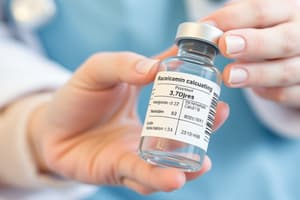Podcast
Questions and Answers
What is the main purpose of the intraventricular route?
What is the main purpose of the intraventricular route?
- Anesthesia during surgeries
- Delivery of fluids during resuscitation
- Treatment of infections and malignancies (correct)
- Access to the spinal cord for pain management
Which route is specifically known for regional anesthesia?
Which route is specifically known for regional anesthesia?
- Intrathecal route
- Epidural route (correct)
- Intracardiac route
- Intraocular route
What is the primary use of the intraosseous route?
What is the primary use of the intraosseous route?
- Providing direct access to the heart
- Diagnosing spinal conditions
- Fluid resuscitation and drug delivery (correct)
- Administering local anesthetics
Which route involves the use of a Tuohy needle?
Which route involves the use of a Tuohy needle?
What is an uncommon use of the intracardiac route?
What is an uncommon use of the intracardiac route?
Which of the following is NOT a purpose of the intrathecal route?
Which of the following is NOT a purpose of the intrathecal route?
What condition is the intraosseous route primarily used for?
What condition is the intraosseous route primarily used for?
Which route is typically injected into the chambers of the eye?
Which route is typically injected into the chambers of the eye?
What does the term 'parenteral' mean?
What does the term 'parenteral' mean?
Which of the following is NOT a common route of parenteral administration?
Which of the following is NOT a common route of parenteral administration?
What is the maximum particle size of the dispersed phase for products administered via the intravenous route?
What is the maximum particle size of the dispersed phase for products administered via the intravenous route?
Which of the following best describes an IV bolus?
Which of the following best describes an IV bolus?
What is the primary characteristic of parenteral products according to USP standards?
What is the primary characteristic of parenteral products according to USP standards?
Which of the following routes is considered specialized in parenteral administration?
Which of the following routes is considered specialized in parenteral administration?
What defines parenteral preparations?
What defines parenteral preparations?
Which of the following routes is used for the administration of drugs directly into the spinal canal?
Which of the following routes is used for the administration of drugs directly into the spinal canal?
What is the primary purpose of continuous infusion?
What is the primary purpose of continuous infusion?
Which type of infusion is specifically associated with patient needs, such as in analgesics?
Which type of infusion is specifically associated with patient needs, such as in analgesics?
Which of the following is NOT considered a common LVP?
Which of the following is NOT considered a common LVP?
What type of infusion is typically used in blood component transfusions?
What type of infusion is typically used in blood component transfusions?
Which infusion pump is specifically designed for self-administration of analgesics by the patient?
Which infusion pump is specifically designed for self-administration of analgesics by the patient?
Which is an indication for administering hyperalimentation?
Which is an indication for administering hyperalimentation?
Which of the following is true regarding dialysis solutions?
Which of the following is true regarding dialysis solutions?
What is one of the primary uses of intravenous admixture?
What is one of the primary uses of intravenous admixture?
What is the main purpose of the intralymphatic route of injection?
What is the main purpose of the intralymphatic route of injection?
What is the maximum volume for small volume parenterals (SVPs)?
What is the maximum volume for small volume parenterals (SVPs)?
Which of the following statements about large volume parenterals (LVPs) is correct?
Which of the following statements about large volume parenterals (LVPs) is correct?
What is a significant requirement for specialized route injections?
What is a significant requirement for specialized route injections?
In which cases can large volume parenterals be administered?
In which cases can large volume parenterals be administered?
What is the volume threshold that distinguishes small volume parenterals from large volume parenterals?
What is the volume threshold that distinguishes small volume parenterals from large volume parenterals?
What type of injection is primarily used for the treatment of IgE-mediated allergic diseases?
What type of injection is primarily used for the treatment of IgE-mediated allergic diseases?
What should be added to multiple dose small volume parenterals to ensure safety?
What should be added to multiple dose small volume parenterals to ensure safety?
What is the primary use of the ID route in medical practice?
What is the primary use of the ID route in medical practice?
Which route of administration is known for its extremely hazardous nature?
Which route of administration is known for its extremely hazardous nature?
Which sequence correctly describes the rate of absorption from fastest to slowest for parenteral routes?
Which sequence correctly describes the rate of absorption from fastest to slowest for parenteral routes?
What type of substances might be injected via the intra-arterial route for diagnostic purposes?
What type of substances might be injected via the intra-arterial route for diagnostic purposes?
In which settings is the intra-articular route primarily utilized?
In which settings is the intra-articular route primarily utilized?
Which of these routes is NOT used for LVP infusion?
Which of these routes is NOT used for LVP infusion?
Which drug type is typically injected into joints through the intra-articular route?
Which drug type is typically injected into joints through the intra-articular route?
What is the maximum volume typically injected using the ID route?
What is the maximum volume typically injected using the ID route?
Flashcards are hidden until you start studying
Study Notes
Parenteral Products Overview
- "Parenteral" derives from the Greek "para enteron," meaning "to avoid the intestines."
- Defined as preparations intended for injection through the skin into blood vessels, organs, tissues, or lesions, ensuring sterility and being pyrogen-free.
- Classified based on the route of administration and volume.
Classification by Route of Administration
-
Common Routes:
- Intravenous (IV): Direct injection into a vein; suitable for all drug classes; includes IV bolus for rapid administration; rate of absorption order: IV > IM > SC > ID.
- Intramuscular (IM): Administered into muscle tissue for moderate absorption time.
- Subcutaneous (SC): Injection into the fatty tissue under the skin.
- Intradermal (ID): Injection into the dermis, mainly for diagnostic tests; volume usually ≤ 0.1 mL.
-
Specialized Routes:
- Administered by trained physicians due to higher risks.
- Intra-arterial: Direct injection into arteries to target specific organs; used for diagnostic angiography and limited use in chemotherapy.
- Intra-articular: Injection into joint spaces for antibiotics, analgesics, and anti-inflammatory treatment.
- Intracisternal: Injection into the cisternal space at the base of the brain, primarily for diagnostics.
- Intraventricular: Injection into brain ventricles for treating infections and malignancies.
- Intrathecal: Injection into the spinal canal for anesthesia, chemotherapy, and pain management.
- Epidural: Injection into the epidural space for regional anesthesia using a Tuohy needle.
- Intracardiac: Direct injection into heart chambers; primarily for emergencies like cardiac arrest.
- Intraocular: Injection into eye chambers; details in ophthalmic chapters.
- Intraosseous: Injection into bone marrow, often used for emergency situations when IV access fails.
- Intralymphatic: Injection into lymph nodes or vessels, used in diagnostics and immunotherapy.
Classification by Volume
-
Small Volume Parenterals (SVPs):
- Volumes below 100 mL, can be single or multiple dose.
- Preservatives added for multiple-dose preparations; total volume must be <30 mL.
-
Large Volume Parenterals (LVPs):
- Volumes above 100 mL, up to 5000 mL; intended for single-dose usage.
- Must be preservative-free and discarded if unused; mostly administered via IV.
- Infusion modes include continuous, discontinuous, volume over time, and dose over time.
- Administered via peripheral veins or central lines.
Uses of Large Volume Parenterals
- Supply electrolytes and nutrients.
- Prevent tissue dehydration.
- Restore blood volume.
- Dilute toxic materials.
- IV admixture for premixed injectable drugs.
Common and Specialized Large Volume Parenterals
-
Common LVPs:
- Lactated Ringer's injection.
- 0.9% Sodium Chloride injection.
- 5% Dextrose injection.
-
Specialized LVPs:
- Hyperalimentation solutions for total parenteral nutrition (TPN).
- Cardioplegic solutions.
- Dialysis solutions (peritoneal and hemodialysis).
- Irrigating solutions (not categorized as parenteral products).
Hyperalimentation Solutions
- Used in TPN, providing nutrients via a central venous catheter.
- Recommended for patients not taking anything orally for over five days.
- Indications include long-term coma, severe gastrointestinal syndromes, and esophageal obstruction.
Studying That Suits You
Use AI to generate personalized quizzes and flashcards to suit your learning preferences.




